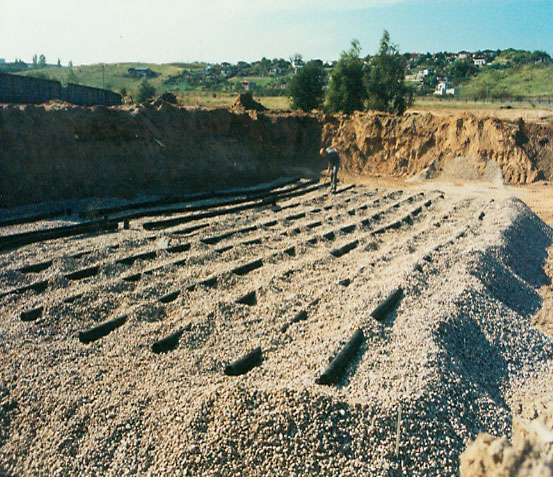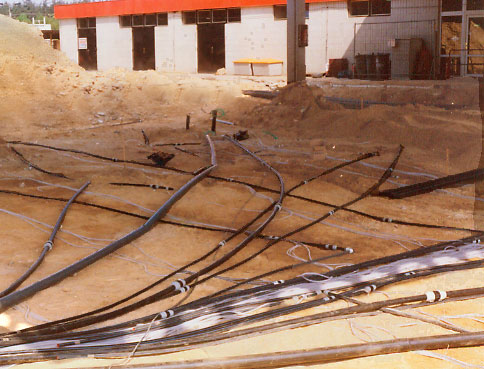


ARGUS Umweltbiotechnologie GmbH



Case-study: Microbiological in-situ Remediation
Case-study: Microbiological in-situ Remediation
Case-study: Microbiological in-situ Remediation
Case-study: Microbiological in-situ Remediation

© 2024 ARGUS Umweltbiotechnologie GmbH

Services
Rotary hoe and tank with nutrients
Drainage with gravel bed
Pipe laying in the area of a motorway service station
Soil remediation
Deciding on a contaminated-soil remediation process depends on the type, size and position of the contamination, as well as particular site conditions and stake-holder interests.
ARGUS Umweltbiotechnologie GmbH applies microbiological and chemical remediation techniques in non-saturated and saturated soils, as well as in groundwater. Both processes can be combined with remediation of highly- impacted contaminant source-zones.
Ongoing usage of the ground surface and buildings during in-situ remediation within the remediated site, is also possible and almost completely without hindrance to site users. This avoids time-consuming and cost-intensive soil excavation works.
ARGUS Umweltbiotechnologie GmbH applies microbiological and chemical remediation techniques in non-saturated and saturated soils, as well as in groundwater. Both processes can be combined with remediation of highly- impacted contaminant source-zones.
Ongoing usage of the ground surface and buildings during in-situ remediation within the remediated site, is also possible and almost completely without hindrance to site users. This avoids time-consuming and cost-intensive soil excavation works.
Microbiological in-situ Processes use the capability of site-specific microorganisms to break down and mineralise organic contaminants in soil, by adding oxygen-donors (for aerobic process), e.g. Molasses/Lactate (for anaerobic process) and/or additional growth factors (substrates, mineral salts).
For microbiological remediation of soil contamination within 1m of groundsurface, we recommend using a soil tiller in conjunction with liquid fertilizer. Landfarming of large surfaces can be achieved cost-effectively in doing so.
Our main application areas for microbiological processes are contamination with:
 •
• Benzene, Toluene, Ethylbenzene and Xylene (BTEX),
Benzene, Toluene, Ethylbenzene and Xylene (BTEX),
 •
• Mineraloil Hydrocarbons (e.g. Diesel, heating oil, transformer oils etc.),
Mineraloil Hydrocarbons (e.g. Diesel, heating oil, transformer oils etc.),
 •
• Polyaromatic Hydrocarbons (PAH)
Polyaromatic Hydrocarbons (PAH)
 •
• Phenols (in particular Alkylphenol) and
Phenols (in particular Alkylphenol) and
 •
• Semi-Volatile Halogenated Hydrocarbons (SVHH)
Semi-Volatile Halogenated Hydrocarbons (SVHH)
 •
• Benzene, Toluene, Ethylbenzene and Xylene (BTEX),
Benzene, Toluene, Ethylbenzene and Xylene (BTEX), •
• Mineraloil Hydrocarbons (e.g. Diesel, heating oil, transformer oils etc.),
Mineraloil Hydrocarbons (e.g. Diesel, heating oil, transformer oils etc.), •
• Polyaromatic Hydrocarbons (PAH)
Polyaromatic Hydrocarbons (PAH) •
• Phenols (in particular Alkylphenol) and
Phenols (in particular Alkylphenol) and  •
• Semi-Volatile Halogenated Hydrocarbons (SVHH)
Semi-Volatile Halogenated Hydrocarbons (SVHH)Based on the specific baseline conditions of the remediation site, we install a system of infiltration groundwater wells, as well as drainage channels and aerators to provide sufficient quantities of oxygen donors, substrates and nutrients for the chosen microorganisms on a continuous or discontinuous basis.
Monitoring wells are used to survey and document development of contaminants, substrate and oxygen as well as redoxpotential. The infiltration regime and oxygen/Molasses/Lactate dosages, together with further additives, are dictated by the monitoring results, in order to continuously optimise the process.
Monitoring wells are used to survey and document development of contaminants, substrate and oxygen as well as redoxpotential. The infiltration regime and oxygen/Molasses/Lactate dosages, together with further additives, are dictated by the monitoring results, in order to continuously optimise the process.



